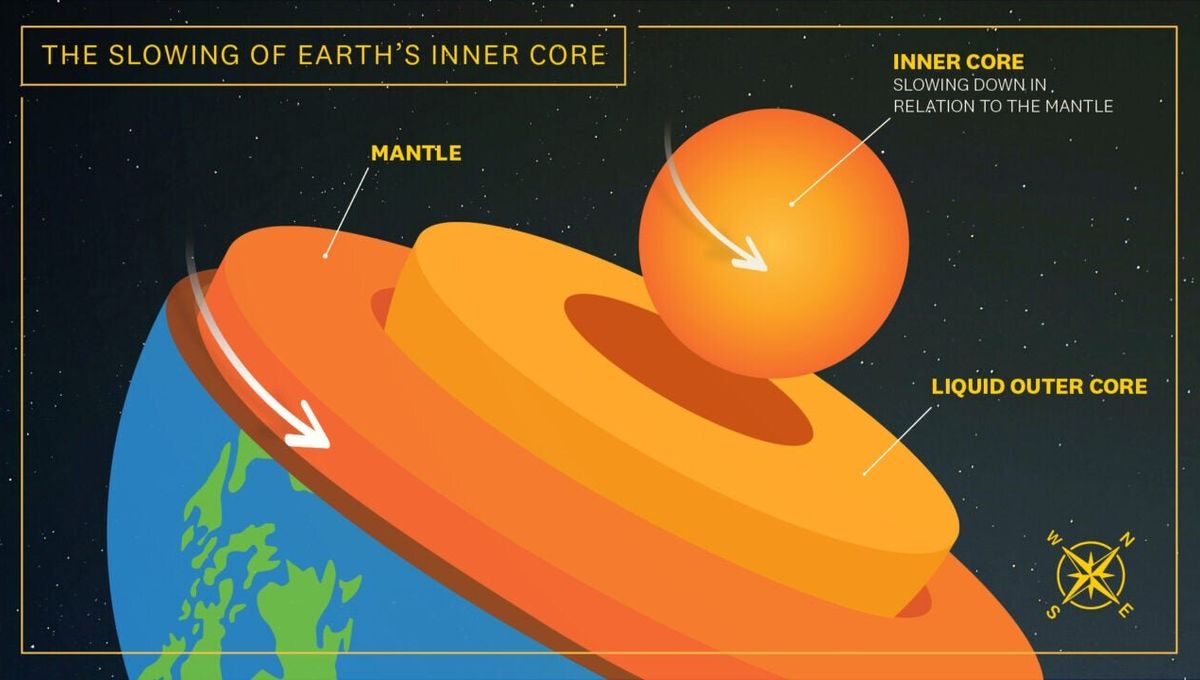
The Earth’s inner core has been slowing down since 2008, the first time this has happened since we have had the capacity to measure it. This could eventually affect the whole planet’s rotation, lengthening our days, but if there are effects big enough for us to notice, they are more likely to be on the geomagnetic field.
The Earth’s core spins in the same direction, and at roughly the same speed, as the rest of the planet. That’s inevitable – after all, it was all formed from the same spinning mass of material, and there continues to be interactions between layers. However, small differences are possible, and for a long time geologists got conflicting answers on whether the core or the surface was rotating faster.
All we know about the core, including its existence, comes from observations of seismic waves from earthquakes (and nuclear testing in the decades when this was widespread) as they are affected by passing through it or bouncing off it.
Changes in the core’s effects on these waves have been interpreted as the result of movements of the core relative to the surface, so that areas of greater or lesser density are underneath the earthquake site.
Professor John Vidale of the University of Southern California compared data from 121 earthquakes that occurred in the South Sandwich Islands between 1991 and 2023 and whose seismic waves were collected in North America, on the other side of the world. Pairs of seismic waves were categorized by similarity, indicating they passed through the same parts of the core.
“We document that many multiplets exhibit waveforms that change and then revert at later times to match earlier events,” Vidale and co-authors write. “The matching waveforms reveal times at which the inner core re-occupies the same position, relative to the mantle, as it did at some time in the past.”
Combined with previous studies, this shows that from 2003-2008 the inner core was “super-rotating”, turning faster than the mantle and crust so that particularly dense patches overtook locations on the surface. From then on, however, the core “sub-rotated”, moving more slowly than the rest of the planet.
The core is still rotating in the same direction as it was before, compared to the universe as a whole, but relative to the surface it is now moving backward. The discrepancy is in fractions of a degree a year. The discrepancy between the core and surface’s rotation was two to three times smaller during this slower period than it was when the core was outpacing the mantle.
“When I first saw the seismograms that hinted at this change, I was stumped,” Vidale said in a statement. “But when we found two dozen more observations signaling the same pattern, the result was inescapable.”
There is a vast amount of angular momentum in the core, so even a small slow-down such as this requires immense forces to be applied. The authors attribute the change to churning in the liquid outer core, as well as the gravitational force applied by areas of the mantle and crust that are unusually dense.
Some of this slower movement will eventually be transferred to the surface, making for longer days. However, Vidale says this will be “very hard to notice, on the order of a thousandth of a second, almost lost in the noise of the churning oceans and atmosphere.”
The Earth’s gravitational field is caused by movements in the outer, not inner, core. Nevertheless, there may be some interaction, and the observed change may relate to unexplained phenomena like the way the magnetic field has sometimes reversed direction.
The study is open access in Nature.
Source Link: The Earth’s Inner Core Has Been Spinning Slower For Over A Decade